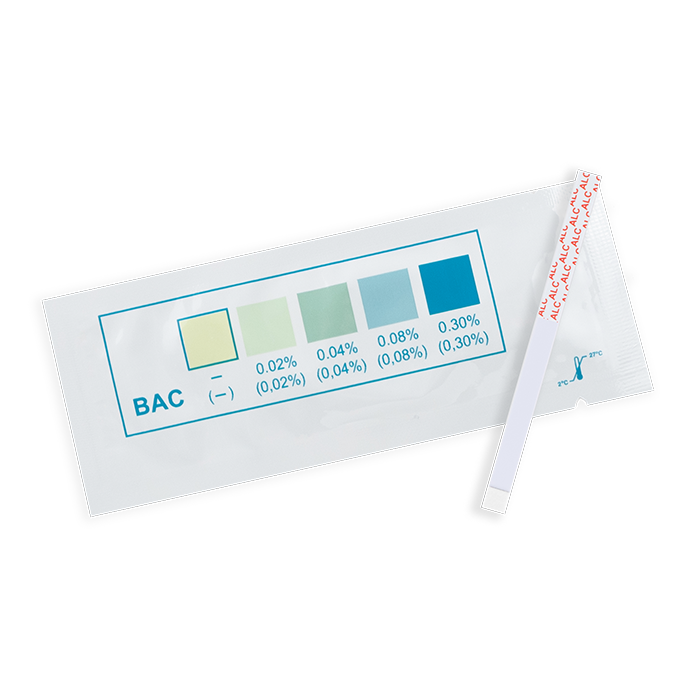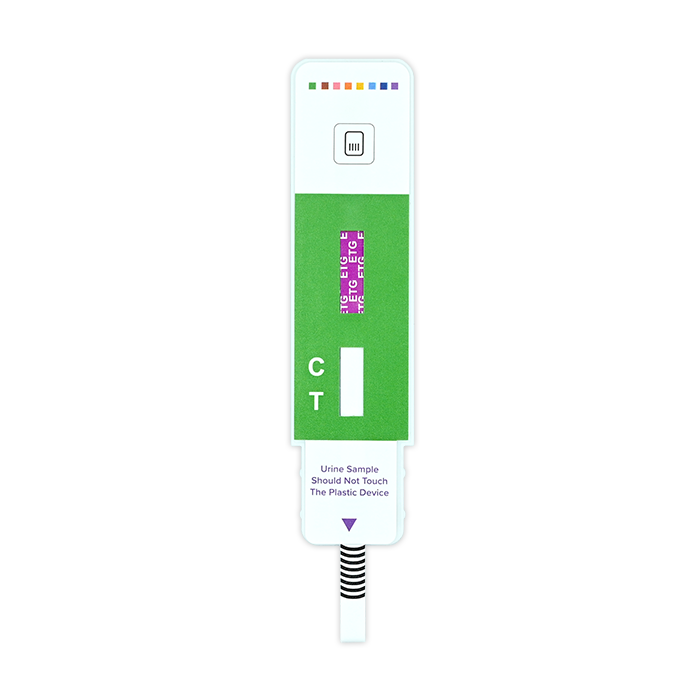Alcohol

Drinking alcohol is a common social practice in many places around the world. Although alcohol may be relatively innocuous when consumed in moderation, but it is an addictive drug that may lead to negative health outcomes. The following Rapid ResponseTM brand products are available for alcohol detection.
Introduction to Alcohol Screening
About Alcohol Testing
Workers under the influence of alcohol while on the job site can compromise their safety but also the health and safety of the work environment. Alcohol testing measures the current alcohol (ethanol) level in the system, which is an indicator of whether someone is intoxicated or not.
Two-thirds of all adults drink alcohol.¹ The blood alcohol concentration at which a person becomes impaired is variable dependent upon the individual. Each individual has specific parameters that affect the level of impairment such as size, weight, eating habits and alcohol tolerance. Inappropriate consumption of alcohol can be a contributing factor to many accidents, injuries, and medical conditions.
Alcohol is absorbed through the stomach and small intestine, which then enters the bloodstream where it remains until the liver metabolizes it. Alcohol tests are used to assess recent alcohol consumption and a person’s level of intoxication. Blood alcohol concentration (BAC) is the amount of alcohol in your blood to the amount of water in your blood. BAC tests are the most common type of alcohol tests used to detect the amount of alcohol a person has consumed.
Types of Alcohol Tests
Breath – Breath alcohol testing is the most common method used. It is minimally intrusive and is highly accurate in measuring levels of consumption and current impairment. This test detects alcohol in human breath, which offers same-day test results in just 2 minutes. An alcohol breath test gives a numerical value of an individual’s BAC.
Urine/Ethyl glucuronide (ETG) – ETG is a minor non-oxidative metabolite of ethyl alcohol. ETG is a product of metabolic process of ingested alcohol (ethanol) that is rapidly metabolized in the body, which is then excreted in the blood, hair and urine. ETG testing can detect ETG in urine, confirming the consumption of alcohol. The ETG metabolite remains in the body longer and therefore has a more useful window of detection of up to 72 hours. ETG testing is an excellent option for zero-tolerance alcohol consumption or rehabilitation programs.
Ethyl glucuronide (ETG) is a metabolite of ethyl alcohol which is formed in the body by glucuronidation following exposure to ethanol, usually from drinking alcoholic beverages. After Alcohol is absorbed by the body, 90-95% Alcohol is oxidized with the help of enzymes. Only 0.5%-1.5% Alcohol integrates with glucose into Ethyl Glucuronide. ETG remains in urine longer than Alcohol. When Alcohol in low volume is consumed (such as 0.1g/kg), the detection window for ETG varies from 13 – 20 hours after drinking. However, the maximum ETG detection window can be 80 hours for high volume of Alcohol consumed.2,3,4,5,6
Saliva – It is well established that the concentration of alcohol in saliva is comparable to that of blood.7,8 The Rapid Response™ Alcohol Test Strip (Saliva) consists of a plastic strip with a reaction pad attached at the tip. On contact with solutions of alcohol, the reaction pad will rapidly change color depending on the concentration of alcohol present. The pad employs a solid-phase chemistry which uses a highly specific enzyme reaction.
Saliva testing is a highly sensitive method to detect the presence of alcohol in saliva and provide an approximation of relative blood alcohol concentration (BAC). Detection limit from 0.02% to 0.30% relative BAC and with results in just 2 minutes.
- Volpicellim, Joseph R., M.D., Ph.D.: Alcohol Dependence:Diagnosis, Clinical Aspects and Biopsychosocial Causes., Substance Abuse Library, University of Pennsylvania, 1997.
- Droenner P, Schmitt G, Aderjan R, et al. A kinetic model describing the pharmacokinetics of ethyl Glucuronide in humans[J]. Forensic Sci Int,2002,126 (1): 24-29.
- Bergström J, Helander A,Jones AW. Ethyl Glucuronide concentrations in two successive urinary voids from drinking drivers:relationship to creatinine content and blood and urine ethanol concentrations[J]. Forensic Sci Int,2003,33(1-2):86-94.
- Wurst FM, Kempter C, Metzger J, et al. Ethyl Glucuronide: a marker of recent alcohol consumption with clinical and forensic implications[J]. Alcohol,2000,20(2):111-116.
- Wurst FM,Vogel R, Jachau K, et al. Ethyl Glucuronide discloses recent covert alcohol use not detected by standard testing in forensic psychiatric inpatients[J]. Alcohol Clin Exp Res,2003,27(3): 471-476.
- HøIseth G, Bernard JP, Karinen R, et al. A pharmacokinetic study of ethyl Glucuronide in blood and urine: applications to forensic toxicology[J]. Forensic Sci Int, 2007, 172(2-3): 119-124.
- Jones, A.W.: Inter-and intra individual variations in the saliva/blood alcohol ratio during ethanol metabolism in man., Clin. Chem. 25, 1394-1398, 1979.
- MaCall, L.E.L., Whiting, B., Moore, M.R. and Goldberg, A.: Correlation of ethanol concentrations in blood and saliva., Clin.Sci., 56, 283-286, 1979.
Rapid Response Tests Comparison
| Product | Details | Features |
| Rapid Response Alcohol Test Strip | Sample: Saliva Format: Strip Time to Result: 2 minutes Test Principle: Colorimetric Analysis Sensitivity: 0.02-0.30% BAC Specificity: Methyl, Ethyl, & Allyl Alcohols Quantity: 50 Tests/Kit |
|
| Rapid Response Ethyl Glucuronide (ETG) Single Drug Test Panel | Sample: Urine Format: Panel Time to Result: 5 minutes Test Principle: Lateral Flow Immunoassay Sensitivity: 500 or 1000 ng/mL Quantity: 25 Tests/Kit |
|
| Rapid Response Alcohol Breath Detector with Blow Bags | Sample: Breath Format: Breathalyzer Time to Result: 2 minutes Test Principle: Chromic Acid Oxidation Sensitivity: 0.02%, 0.04%, 0.05%, 0.06%, 0.08%, or 0.10% BAC Specificity: Ethyl Alcohol & other Volatile Alcohols Quantity: 3 or 15 Tests/Kit |
|
| Rapid Response Alcohol Breath Detector | Sample: Breath Format: Breathalyzer Time to Result: 2 minutes Test Principle: Chromic Acid Oxidation Sensitivity: 0.02%, 0.04%, 0.05%, 0.06%, 0.08%, or 0.10% BAC Specificity: Ethyl Alcohol & other Volatile Alcohols Quantity: 3 or 20 Tests/Kit |
|
Find the best solution for your needs
Our sales representatives can help set you up for success! Contact our team today!
The length of time alcohol stays in the body is dependent on factors such as the individual’s size, weight, eating habits, alcohol tolerance, and amount of alcohol consumed.
Your body metabolizes alcohol at a constant rate, at about one drink per hour. How fast a person’s body metabolizes alcohol can vary based on factors such as gender, age, eating habits, and more.
Approximately five percent of ingested alcohol is expelled from the body through urine, sweat glands, and breathing. Majority of the alcohol is metabolized by the liver to eliminate it from the body. When blood alcohol levels exceed the liver’s detoxification process, this leads to unmetabolized alcohol that continues to circulate in the bloodstream. When there is an accumulation of alcohol in the body, intoxication occurs.
There are numerous factors that affect how fast the body metabolises alcohol, including gender, age, consumed food, time of day, physical activity, and amount of alcohol consumed.
Collected samples that are incorrectly handled that become contaminated during testing and failure to follow the testing instructions for the test may cause false results.
Sex, age, physical condition, and the amount of food or drugs consumed may affect the test. A person under the influence of alcohol may test negative.
Alcohol tests are highly sensitive to alcohol and alcohol vapors in the air, such as disinfectants, deodorizers, perfumes, and glass cleaners, which may cause false results.
| BAC Level | Effects |
| 0.02 | Some loss of judgement, slight body warmth, altered mood |
| 0.05 | Exaggerated behavior, reduced coordination and focus, lowered inhibitions |
| 0.08 | Poor coordination, loss of judgement, concentration, self-control, impaired perception |
| 0.10 | Reduced reaction time and control, slurred speech, poor coordination, slowed thinking, inability to maintain lane position |
| 0.15 | Far less muscle control than normal, vomiting may occur, loss of sense of balance, impaired vehicle control or driving |



 Canada
Canada